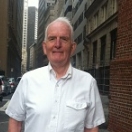
 Bob Sloane is being honored as a Champion of Change for his time and effort developing innovative ways to help grow and expand the transportation industry.
Bob Sloane is being honored as a Champion of Change for his time and effort developing innovative ways to help grow and expand the transportation industry.
In the last few years, walking has come to be recognized as one of the best - and certainly the cheapest - methods of maintaining personal health. Both older and younger generations are moving into places where they can walk during their regular daily activities. People are being reminded that a benefit of walking is that you see and experience things you’d miss using other modes of travel. Walkability has even become a way to market real estate.
It’s been a gradual happening. Twenty-two years ago, I worked with four others to form WalkBoston, the first pedestrian advocacy group in America. Since that time WalkBoston has become Massachusetts’ leading organization in raising awareness about the importance of walking and the need to create pedestrian-friendly built environments.
To inspire and motivate people to walk, WalkBoston began creating detailed, easy to use, self-guided maps in 1995. Early maps focused on historic sites, stopping points and views that could be included in relatively short walking tours. We prepared maps on single sheets and published a book of walks in 30 neighborhoods in and near Boston.
In 2006, we made a significant change. In that year, a section of tunnel ceiling in Boston’s Big Dig collapsed and killed a passenger in a car, and the City’s roadway network was seriously disrupted. WalkBoston staff brainstormed how to be helpful during this traumatic episode and decided to create a map to show how easy it is to avoid driving and get around downtown Boston on foot.
The new map was innovative in showing timed walking routes broken into segments of five-minutes between key transit stations, intersections and attractions in Boston. Our new maps recognized that people often think of distance in terms of travel times, yet most maps don't provide this information. Walks comprised of five-minute segments to convey the walkability of an area. With information more easily understood by the reader, our maps became more effective in encouraging people to walk.
When the map was printed and posted online, it was instantly successful. Users were astounded that places in Downtown Boston were so close together in terms of time. Maps have now been prepared for dozens of communities to encourage walking by showing the short distances between major landmarks. We always work in concert with local experts and non-profit organizations to develop the map’s particular theme. WalkBoston now has over 60 maps for cities and towns around the state, with more in production.
Bob Sloane is a Senior Planner at WalkBoston.


